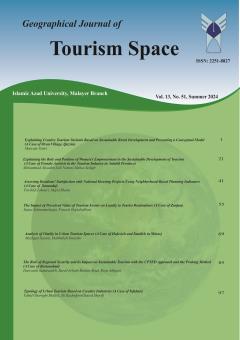Assessing residents' satisfaction with national housing projects with neighborhood-based planning indicators (Case example: Sanandaj city)
Subject Areas :Farshid zohouri 1 * , Majid Shams 2
1 - PhD Student, Department of Geography and Urban Planning, Malayer Branch, Islamic Azad University, Malayer, Iran
2 - Professor, Department of Geography and Urban Planning, Malayer Branch, Islamic Azad University, Malayer, Iran
Keywords: national housing, neighborhood-based planning, satisfaction, evaluation, Sanandaj ,
Abstract :
The lack of proper planning for housing aimed at low-income and vulnerable urban populations, coupled with the unchecked involvement of profit-driven actors in the housing sector, has created an urgent need for more effective housing strategies. One critical aspect of urban management is ensuring the satisfaction of residents in housing complexes. This study aims to evaluate residents’ satisfaction with national housing projects using neighborhood-based planning indicators, focusing on physical, economic, environmental, and welfare dimensions. The objective is to assess how these indicators can enhance the efficiency of National Housing Movement sites in Sanandaj. The research adopts a descriptive-analytical approach.
1. برقی، حامد، 1390. رضایتمندی ساکنان روستایی در تبدیل نقاط روستایی به شهر، فصلنامه علمی پژوهشی جغرافیا، شماره 2، ص 35-63.
2. پورمحمدی، م، 1391. برنامهریزی مسکن، چاپ دهم. انتشارات سمت. 172 صفحه.
3. حقیقتیان، م، عوامل مؤثر بر شادمانی، فصلنامه علمی راهبردی اجتماعی فرهنگی، شماره 2، ص 26-47.
4. رفیعیان، مجتبی، عسگري زاده، زهرا، 1388. رضایت مندي شهروندان از محیطهاي سکونتی شهري، مجله علوم محیطی، سال هفتم، شماره اول، پاییز 1388، ص 41-68.
5. زیاری، ک، آقاجانی، م،1390. بررسی وضعیت مسکن گروههای درآمدی و برآورد مسکن گروههای آسیبپذیر (نمونه موردی استان هرمزگان)، فصلنامه تحقیقات جغرافیایی، شماره 3 (پیاپی98)، ص29-55.
6. شکری یزدان آباد، ش، بهزدافر، م، عوامل مؤثر بر تحقیق برنامهریزی محله مبنا، مجله مطالعات ساختار و کارکرد شهری، شماره 1، ص 53-84.
7. فتحی، ع، چاره جو، ف، بررسی نقش مشارکت شهروندان در برنامهریزی و توسعه پایدار محلهای شهر سنندج، جغرافیا و آمایش شهری منطقه ای، شماره 4، ص 36-62.
8. مهدوی، م.، طاهرخانی، م، 1385.کاربرد آمار در جغرافیا. نشر قومس، تهران. 210 صفحه.
9. نسترن، م، رعنایی، آ، 1390. تحلیلی بر مفهوم مشارکت و کار گروهی در پروژههای آماده سازی اراضی مسکن مهر، فصلنامه معماری و شهرسازی آرمان شهر، شماره 4، ص111-123.
10. واحدی یگانه، ف، محمدی، آ، 1395. نقش پروژههای محرک توسعه در سیاستهای بازآفرینی. فصلنامه اقتصاد و برنامهریزی، شماره 3، ص 23-48.
11. Bernanke, B.S, Gerler, M and Gilchrist, s.1999, The financial accelerator in A quantitative business cycle framework. In J. B. Taylor&M. Woodford (Eds), Handbook of Macroeconomics.340-360.
12. Teck-Hong. T, (2012), Housing satisfaction in medium-and high-cost housing: The case of Greater Kuala Lumpur, Malaysia, Habitat International 36. 221-240.
13. Glass, j., simon,r., Andersson, M, Effects of work-Family Reconciliation policies in 22 OECD Countries. 410-430.
14. Montgomery, H., Johansson, U.S (1988), Life values: their structure and relation to life conditions. Applied Behavioral Economics, Vol 1,420-437.

